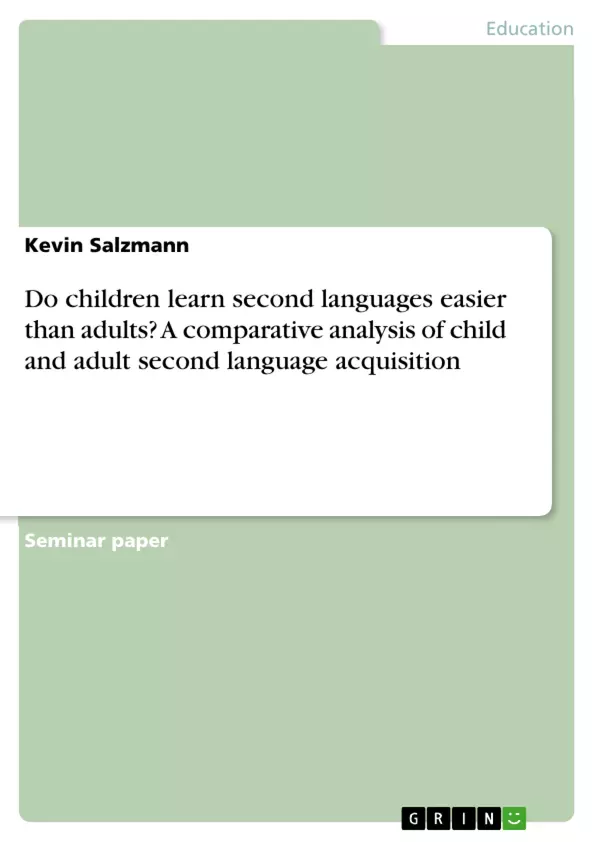In the field of Second Language Acquisition (SLA), researchers often get confronted with a controversial issue: Are children better second language learners than adults? Do they always outperform older learners?
After a general introduction into the field of SLA, this term paper focuses on the relevance of age in second language learning. Theories of critical and sensitive periods during the learning process will be examined in order to emphasize that age has an important impact on effective SLA. Afterwards, specific differences in child and adult SLA will be taken into consideration; how do children acquire a second language and how is it different from the acquisition of an old- er person? By answering these questions differentiated it might be possible to come to a conclusion whether children or adults are better second language learners.
Inhaltsverzeichnis (Table of Contents)
- Introduction
- A definition of Second Language Acquisition (SLA)
- The role of age in SLA
- Critical and sensitive periods in the learning process
- The relevance of age in SLA
- Differences in child and adult SLA
- Conclusion
- References
- Declaration of Authorship
Zielsetzung und Themenschwerpunkte (Objectives and Key Themes)
This paper aims to explore the role of age in Second Language Acquisition (SLA), specifically investigating whether children are better second language learners than adults. It examines the concept of critical and sensitive periods in the learning process to understand how age impacts effective SLA. The paper then analyzes specific differences in child and adult SLA to determine if there is an optimal age for acquiring a second language. Key themes include:- The impact of age on second language acquisition.
- Critical and sensitive periods in language learning.
- Differences in how children and adults acquire a second language.
- The role of social interaction and acculturation in L2 learning.
- The influence of motivation and crosslinguistic influences on SLA.
Zusammenfassung der Kapitel (Chapter Summaries)
The introduction sets the stage by highlighting the debate surrounding the impact of age on second language acquisition. It emphasizes the significance of the question and introduces the key aspects that will be explored in the paper, such as critical periods and maturational constraints. The paper also emphasizes the need for understanding the broader context of SLA, including aspects like motivation, crosslinguistic influences, and social dimensions.
Chapter 2 provides a definition of Second Language Acquisition (SLA), explaining the core concept and contrasting it with first language acquisition. It also delves into the importance of both naturalistic and instructed learning environments in SLA. Additionally, the chapter discusses the role of acculturation and its influence on L2 success, drawing on the "Acculturation Model" proposed by John Schumann. Finally, the chapter outlines three key environmental ingredients for optimal L2 learning: acculturated attitudes, comprehensible input, and negotiated interaction.
Schlüsselwörter (Keywords)
This paper focuses on the key concepts of Second Language Acquisition (SLA), age, critical periods, sensitive periods, child SLA, adult SLA, maturational constraints, social interaction, acculturation, and language learning success. The study aims to provide insights into the role of age in second language acquisition and the differences between how children and adults learn languages.- Arbeit zitieren
- Kevin Salzmann (Autor:in), 2014, Do children learn second languages easier than adults? A comparative analysis of child and adult second language acquisition, München, GRIN Verlag, https://www.grin.com/document/274430



